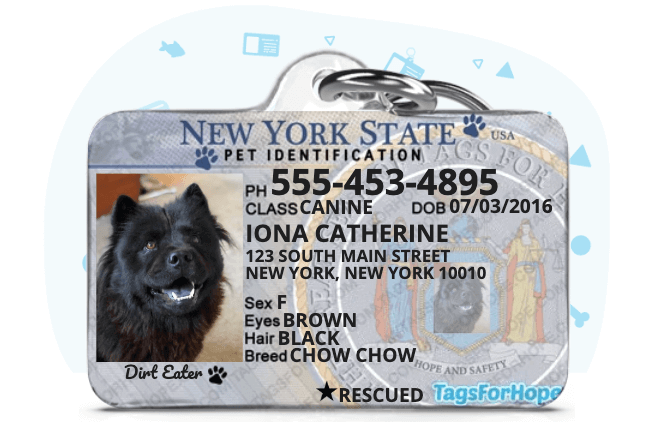April 14th through 20th is National Pet ID week!
Take this week to either get your pet microchipped or double check your information to make sure it's up to date. Losing a pet is one of the worst things that can happen as a pet owner. Taking simple and small steps to help bring your pet home can make the difference between finding your pet and not. Here are some tips to make sure your pets return home in case they escape or get lost.
1. Get your pet microchipped. 
$60 is a small price to pay for peace of mind if your pet does get lost. A Microchip is an electronic chip encased in glass about the size of a grain of rice. The Microchip is inserted under the skin without any anesthesia or in conjunction with surgery such as a spay or neuter. Once inserted under your pet's skin the microchip requires no batteries and allows rescue groups, animal hospitals, and shelters to pull up that microchip's unique number. However, microchipping you pet is half the battle. After the microchip is inserted under the skin, you as the owner must register the chip and make sure to keep your information up to date.
2. Keep all information up to date.
This is the big one. Microchips are almost useless unless they are registered and kept up to date with your current information. It may be a good idea to scan your pet and double check your info at their yearly checkup.
3. Make sure your pet always has an ID tag on their collar.
 This is a small and easy way to try and reunite a lost pet with their owners. While microchipping is a great backup, an ID tag is a quick and easy way to bring a lost pet home. Make sure to put at least your up-to-date phone number and name on the tag. Most pet stores allow you to customize a pet ID tags so adding an address or a secondary contact is always a good idea. A company called Tags For Hope will create a drivers license ID tag for your pet with your address, phone number, and on top of that, the back is 100% customizable! You upload a photo of your pet, pick which state, province, or country to model the ID after and they'll ship a high quality, life proof ID tag for your pet. They also make wallet ID cards for you for quick reference. Plus with each purchase, they help provide food, shelter, and medical treatments to homeless pets in need.
This is a small and easy way to try and reunite a lost pet with their owners. While microchipping is a great backup, an ID tag is a quick and easy way to bring a lost pet home. Make sure to put at least your up-to-date phone number and name on the tag. Most pet stores allow you to customize a pet ID tags so adding an address or a secondary contact is always a good idea. A company called Tags For Hope will create a drivers license ID tag for your pet with your address, phone number, and on top of that, the back is 100% customizable! You upload a photo of your pet, pick which state, province, or country to model the ID after and they'll ship a high quality, life proof ID tag for your pet. They also make wallet ID cards for you for quick reference. Plus with each purchase, they help provide food, shelter, and medical treatments to homeless pets in need.
4. If your pet does get out, start looking immediately.
Seems like a no-brainer but people tend to assume their pets, especially cats, will make their way home and delay a search. Don't do this. Alert shelters and neighbors, make fliers with your pets photos and up-to-date contact info, even reaching out to local veterinary hospitals is a good idea so they can also be on the lookout as well.
Did you know that some breeds are more prone to escaping than others?
Besides being in their nature, dogs tend to escape for a few good reasons. If they aren't fixed, hormones can cause dogs and cats to wander in search of a mate. Loud noises such as storm and fireworks can also scare your pet into trying to escape. Others tend to wander because they are bored and lonely. Leaving a dog outside and alone for long periods of time isn't always in their best interest despite what you may think. Any dog may feel the need for freedom, but take note of this short list of dogs more prone to escaping.
- Siberian Huskies: These sled dogs were bred to be working almost every day of their lives. This ancient desire to run and be active hasn't gone away, and with their masterful digging skills paired with their high prey drive and curiosity, boredom can often make them a huge flight risk. So much so, it has been recommended that on top of a 7ft fence, owners should dig and pour a 3ft concrete barrier underneath their fence to prevent escape.
- Labrador Retrievers: The Lab's friendly disposition and curious nature tend to lead them to be a very loving dog, to everything and everyone. Prone to separation anxiety, these family favorites have been known to go above and beyond to get out and interact with the world.

- Boxers: These muscular dogs have no trouble clearing a 6ft fence and their playful nature and high energy can lead them to want to take a game of chase outside of your yard. Online Boxer forms call this masterful art of escaping Boxer-Bolting.
- Chihuahuas: Despite their small size Chihuahuas have a lot of energy to burn. They require the same if not more time, energy, and training than their large breed counterparts. These quick fellows love being close to their humans so if they aren't getting a lot of attention they may try and find it elsewhere.
- Beagles: Hunting bred dogs are at a big-time risk for escape. Unless actually trained for retrieval, many hounds will follow their noses no matter where it takes them and might not always return.

- German Shepherds: Herding breeds are also at a risk for escape. Trained to herd, this instinct rarely goes away and that desire to chase down other, smaller animals can lead to big problems. On top of this, German Shepherds are prone to separation anxiety. A condition that can lead your pup to come looking for you.
Training, proper socialization, and exercise are all great ways to prevent boredom and ultimately escape.
Take the time to double check your yard, your pets microchip information and come up with a game plan if your pet was to escape. For more info on microchipping, check out our blog "Why Microchip Your Dog?"

